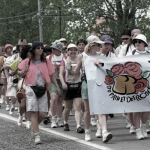Working conditions on today’s construction sites and factory floors, in schools, office buildings, warehouses, restaurants – any workplace, really – are often taken for granted. We see fire extinguishers and sprinklers, first aid stations and emergency exits. We see the safety barriers, the hard hats, and the labels that warn of explosives, poisons and burns. We know they are there to keep us safe, but forget how they got there in the first place.
In 1960, work on the Hogg’s Hollow water main was in full swing. Built under the Don River to connect a pumping station with the water distribution on the other side, the work was done mostly by hand, in cramped and confined quarters 10 meters underground. It was also nearly a year behind schedule, the result of a failed contractor, faulty equipment and other delays. Pressure to finish the work resulted in corners being cut with disastrous consequences.
The underground workers that build tunnels for city water works and subways are known as “sandhogs”, and their working conditions were often more reminiscent of the 19th century than a modern, post-war Canadian city.
Workers later testified that the tunnels lacked fire extinguishers and resuscitators, the timber supports were not strong enough, grout was not used on the floor of the tunnel to keep out sand and silt, and there were no extra air compressors. They didn’t even have flashlights. In spite of these issues, the site had been deemed to meet the safety standards of the day.
Late on Thursday March 17, hours after work should have stopped, a dozen workers were still underground welding steel plating in a compression chamber west of Yonge Street when a fire started and smoke began to fill the main tunnel. A valve that would have allowed the smoke to blow out of the tunnel would not open.
Firefighters arrived quickly, but were told to wait at least 30 minutes before watering the tunnel for fear it would collapse. While half of the workers had managed to escape down the tunnel to the east, the rest were trapped inside with riding temperatures, toxic smoke and rising levels of sand, silt and water. Two workers tried to get down to the trapped men and thought they heard at least three voices moaning, but were forced back by the intense heat. The next day Pasquale Allegrezza, Giovanni Carriglio, Giovanni Fusillo, and brothers Alessandro and Guido Mantella were dead – poisoned by carbon monoxide and drowned.
A coroner’s jury later ruled that the deaths were preventable, “the inevitable result of the failure to implement and enforce regulations.” The resulting media coverage, community outrage and demands from unions forced the Ontario government to call a Royal Commission, which led to new regulations on fire protection, worker safety in tunnels and the first overhaul of the province’s labour laws in nearly 40 years. It also spurred the organization of more construction workers and more immigrant workers into unions, so they could stand up for their rights, health and safety.
Disasters like the tragedy at Hogg’s Hollow, the Heron Road Bridge collapse in Ottawa, and the Westray Mine cave in years later all changed workplace health and safety laws by shining a light on the unsafe and, in the case of the five immigrant workers killed at Hogg’s Hollow, unfair conditions faced too often by many working people. In 1984, the Canadian Labour Congress established a National Day of Mourning for workers killed and injured on the job to keep pressure on employers and politicians.
Today, unions continue to stand up for fairness, safety and the health of workers with winning campaigns to ban asbestos, prevent workplace harassment and violence, win supports for workers experiencing domestic violence, and help working people struggling with mental illness.


